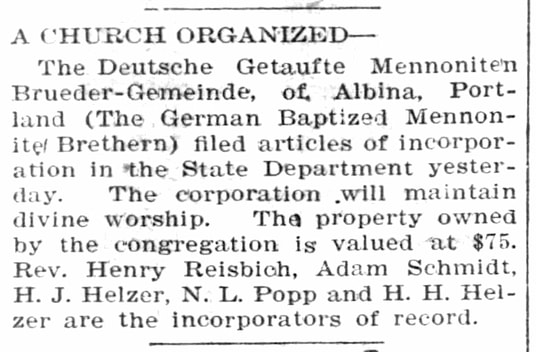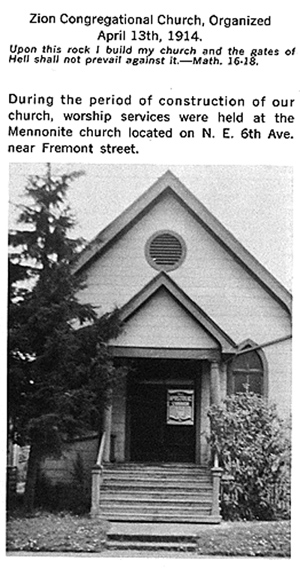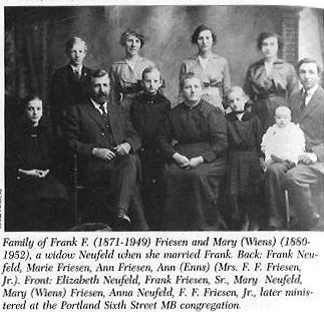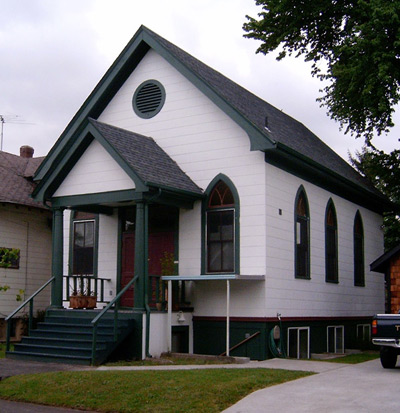First United Mennonite Baptist Church
The Mennonite Brethren are part of the more extensive Christian expression called Anabaptism (meaning "baptized again"). This group of Mennonites adopted Baptist principles but tried to uphold their distinctiveness as Mennonites. Their identity is founded in 475 years of witness since the Reformation. Many German Mennonites immigrated to North America from the Russian empire and settled in the Midwest and Canada regions of the United States and Canada. Some of them found the winters quite harsh, especially in Canada, and sought warmer climates. Some of those came west to Oregon and settled in Portland. Mission work in Portland appears to have been especially difficult, and there were many unsuccessful attempts by several Mennonite groups in Oregon before viable congregations resulted.
According to Kevin Enns-Rempel, archivist at the Center for Mennonite Brethren Studies in Fresno, California, the Portland Mennonite Brethren Church was made up mainly of Volga Germans and was, therefore, culturally different from the larger Mennonite Brethren Church. The Volga Germans were generally Lutheran, Reformed, or Catholic in Russia. The Volga Germans spoke a different German dialect from the "Low German" Mennonites, who mostly lived further west from the Volga. Some of these Volga Germans joined the Mennonite Brethren Church in Russia, and others did so after the migration to North America in the 1870's. The Sutton and Hastings, Nebraska Mennonite Brethren Churches were made up almost entirely of such Volga German converts to the Mennonite Brethren Church. Many Portland Mennonite Brethren Church members may have come from Sutton or Hastings. This was true for ministers Heinrich Hölzer (also Helzer, Hilser, or Helser), Heinrich Reisbich, Conrad Heinrich Urbach, and deacon Nickolas L. Popp. The first four ministers of the church were either born in Norka, Russia, or descended from parents born there.
Mr. Enns-Rempel states little is known about the Portland Mennonite Brethren Church. The church was never large, was geographically isolated from other Mennonite Brethren congregations, was culturally distinct from the larger Mennonite Brethren Church, and seems to have left behind little documentary evidence from which historians might work.
Some of the families in the church included Cook (Koch), Dill, Fast*, Friesen*, Heinrich, Helser, Huwa, Koch, Martens*, Nachtigal (Nightengale)*, Pauli, Popp, Reisbich, Ross, Sauer, Schnell, Schwindt, Singer, Sittner, Urbach, and Wittenberg. (* = Family surnames believed to be Mennonite in origin. Other surnames appear to belong to Volga German families.)
According to Kevin Enns-Rempel, archivist at the Center for Mennonite Brethren Studies in Fresno, California, the Portland Mennonite Brethren Church was made up mainly of Volga Germans and was, therefore, culturally different from the larger Mennonite Brethren Church. The Volga Germans were generally Lutheran, Reformed, or Catholic in Russia. The Volga Germans spoke a different German dialect from the "Low German" Mennonites, who mostly lived further west from the Volga. Some of these Volga Germans joined the Mennonite Brethren Church in Russia, and others did so after the migration to North America in the 1870's. The Sutton and Hastings, Nebraska Mennonite Brethren Churches were made up almost entirely of such Volga German converts to the Mennonite Brethren Church. Many Portland Mennonite Brethren Church members may have come from Sutton or Hastings. This was true for ministers Heinrich Hölzer (also Helzer, Hilser, or Helser), Heinrich Reisbich, Conrad Heinrich Urbach, and deacon Nickolas L. Popp. The first four ministers of the church were either born in Norka, Russia, or descended from parents born there.
Mr. Enns-Rempel states little is known about the Portland Mennonite Brethren Church. The church was never large, was geographically isolated from other Mennonite Brethren congregations, was culturally distinct from the larger Mennonite Brethren Church, and seems to have left behind little documentary evidence from which historians might work.
Some of the families in the church included Cook (Koch), Dill, Fast*, Friesen*, Heinrich, Helser, Huwa, Koch, Martens*, Nachtigal (Nightengale)*, Pauli, Popp, Reisbich, Ross, Sauer, Schnell, Schwindt, Singer, Sittner, Urbach, and Wittenberg. (* = Family surnames believed to be Mennonite in origin. Other surnames appear to belong to Volga German families.)
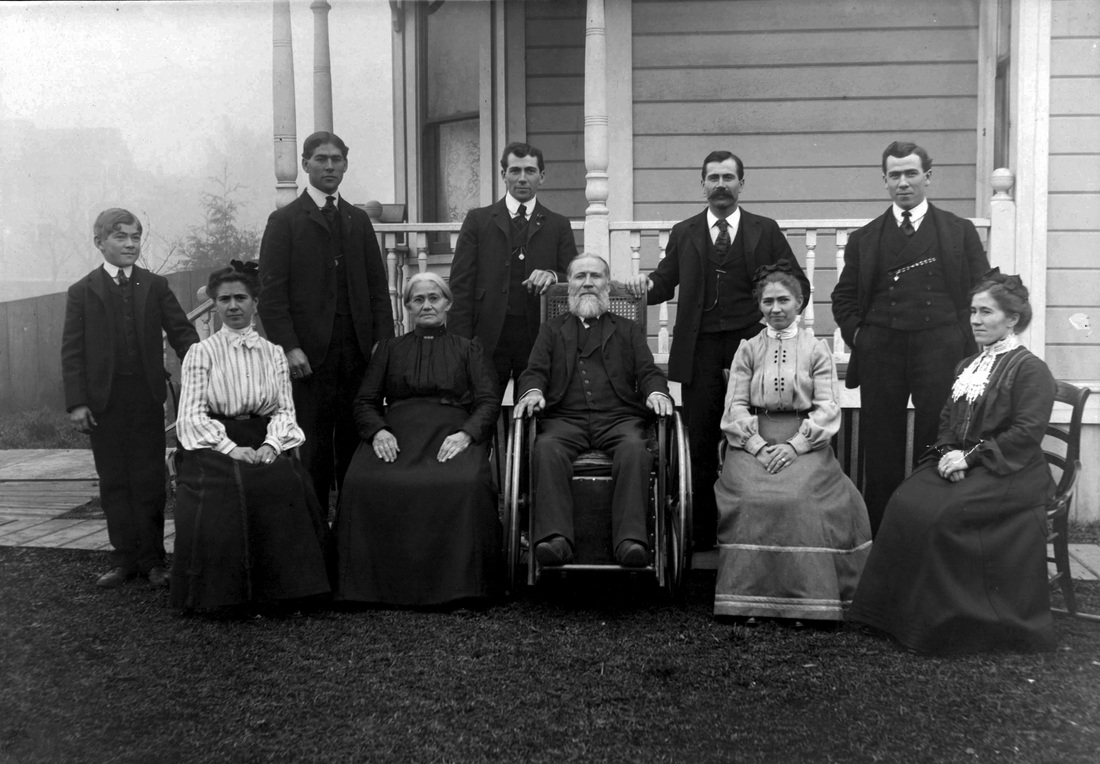
Photograph of Heinrich Helser (seated in the wheelchair) next to his wife Christina (née Ross). Standing from left to right: George Samuel, John Charles, Marnell Jack, Heinrich (Henry), Peter Frederick. Sitting from left to right: Emma, Christina, Heinrich (Henry) H. Sr., Magdalene (Lena), Christine. The photo was taken in 1900 at the home of Heinrich and Christina in Portland. Photograph and description contributed by Loretta Woodward and Marna Helser Hing.
According to the limited available documents, the Mennonite Brethren congregation began meeting in the Albina area of Portland by 1891, ten years after the arrival of the first Volga Germans in Portland. By 1892, the church had 22 members, and Heinrich H. Helser was the church's leader.
Heinrich Helser was born January 17, 1844 in Norka, Russia. Heinrich married Christina Ross, who was also born in Norka. Heinrich and Christina left Norka in 1878, bound for America. They first settled in Hastings, Nebraska, where they lived in a Mennonite community. The commune had a large central house surrounded by cottages. By November 1891, the Helsers had settled in Portland.
Articles of Incorporation for the congregation were filed in 1893. By 1895, there were 38 church members, and the group was considered part of the Mennonite Brethren home mission work.
Heinrich Helser's leadership of the church ended in 1900. Around this time, approximately thirty-three members of the Mennonite Brethren Church decided to disband their congregation. They were accepted as members of the Albina German Baptist mission, which subsequently became the Second German Baptist Church. Within a short time, members of the Mennonite Brethren breakaway group became disenchanted with the Albina German Baptist Mission. They formed a new congregation known as the First United Mennonite Baptist Church.
New Articles of Incorporation were filed with the State of Oregon on May 1, 1902, for the Deutsche Getaufte Mennoniten Brueder-Gemeinde of Albina, Portland (The German Baptist Mennonite Brethren Congregation of Albina in Portland). Rev. Johann Heinrich (Henry) Reisbich became the leader of the church. Like Henry Helser, Rev. Reisbich was also born in Norka, Russia. Also mentioned as incorporators are Adam Schmidt, H.J. Helser, Nickolas L. Popp and H.H. Helser (the son of Henry Helser).
Heinrich Helser was born January 17, 1844 in Norka, Russia. Heinrich married Christina Ross, who was also born in Norka. Heinrich and Christina left Norka in 1878, bound for America. They first settled in Hastings, Nebraska, where they lived in a Mennonite community. The commune had a large central house surrounded by cottages. By November 1891, the Helsers had settled in Portland.
Articles of Incorporation for the congregation were filed in 1893. By 1895, there were 38 church members, and the group was considered part of the Mennonite Brethren home mission work.
Heinrich Helser's leadership of the church ended in 1900. Around this time, approximately thirty-three members of the Mennonite Brethren Church decided to disband their congregation. They were accepted as members of the Albina German Baptist mission, which subsequently became the Second German Baptist Church. Within a short time, members of the Mennonite Brethren breakaway group became disenchanted with the Albina German Baptist Mission. They formed a new congregation known as the First United Mennonite Baptist Church.
New Articles of Incorporation were filed with the State of Oregon on May 1, 1902, for the Deutsche Getaufte Mennoniten Brueder-Gemeinde of Albina, Portland (The German Baptist Mennonite Brethren Congregation of Albina in Portland). Rev. Johann Heinrich (Henry) Reisbich became the leader of the church. Like Henry Helser, Rev. Reisbich was also born in Norka, Russia. Also mentioned as incorporators are Adam Schmidt, H.J. Helser, Nickolas L. Popp and H.H. Helser (the son of Henry Helser).
In 1905, the church was located at 313 Russell (now about 70 NE Russell), presumably on the property mentioned in the 1902 Articles of Incorporation. This was likely a small building that was quickly outgrown.
A new church building was constructed at 3524 NE 6th Avenue in 1910. Membership was 37 people in 1912. Rev. Henry Reisbich served the congregation until 1913. The new church building served as a temporary sanctuary for the newly formed Zion German Congregational Church in 1914. The Zion church was initially organized in the home of Conrad Helzer, possibly a relative of Heinrich Helser.
A new church building was constructed at 3524 NE 6th Avenue in 1910. Membership was 37 people in 1912. Rev. Henry Reisbich served the congregation until 1913. The new church building served as a temporary sanctuary for the newly formed Zion German Congregational Church in 1914. The Zion church was initially organized in the home of Conrad Helzer, possibly a relative of Heinrich Helser.
In these early years, there were tensions within the congregation due in part to some members' Seventh Day Adventist and Baptist influence and perhaps due to the tensions between Volga Germans and ethnic Mennonite Brethren. The congregation appears to have always struggled during its lifetime.
The church was viewed as a home mission during much of its existence. The Portland and Dallas, Oregon churches related to other Mennonite Brethren conferences until the Pacific District Council (PDC), comprised of congregations in Washington, Oregon, and California, organized in 1913. By 1916, and for some years following, there was both a home mission and congregation in Portland, with the two merging in 1930.
For many years, the congregation lacked strong resident leadership, and for some years, ministers from the church in Dallas, Oregon, preached regularly in Portland, as often as every other Sunday. Ministers Peter C. Hiebert (1907-1908) and Heinrich S. Voth (1909-1915) often filled the void.
It is remembered that a lame baker, a single man named Peter Heinrich, would regularly send a long green box with two layers of cookies home with Rev. Heinrich Voth after his weekend in Portland. According to the PDC yearbooks, Peter Heinrich, who was also born in Norka, Russia, served as the church's lay leader from 1913 until he moved to California in 1926, often with an ordained preacher or two and a deacon. By 1926, church membership had declined to 10 people.
New Articles of Incorporation were filed in 1927, and Conrad Heinrich Urbach, the son-in-law of Henry Reisbich, became the church's lay leader, serving until 1934. Membership fluctuated widely during these years. In these years, the stress of adapting to urban culture and financial problems contributed to the church's demise. Even among German-speaking people living in the area, mission outreach never prospered greatly. The response of younger people to cultural changes in the larger world brought considerable conflict and stress, as in other Volga German churches. The loss of more youthful people continued the decline of the congregation, and the work nearly ended in 1932 but revived in 1933,
Jacob Koch began leadership of the church as a layman in 1934 and continued until 1936.
In 1937, Rev. Frank F. Friesen assumed leadership of the struggling congregation with only 24 members.
The church was viewed as a home mission during much of its existence. The Portland and Dallas, Oregon churches related to other Mennonite Brethren conferences until the Pacific District Council (PDC), comprised of congregations in Washington, Oregon, and California, organized in 1913. By 1916, and for some years following, there was both a home mission and congregation in Portland, with the two merging in 1930.
For many years, the congregation lacked strong resident leadership, and for some years, ministers from the church in Dallas, Oregon, preached regularly in Portland, as often as every other Sunday. Ministers Peter C. Hiebert (1907-1908) and Heinrich S. Voth (1909-1915) often filled the void.
It is remembered that a lame baker, a single man named Peter Heinrich, would regularly send a long green box with two layers of cookies home with Rev. Heinrich Voth after his weekend in Portland. According to the PDC yearbooks, Peter Heinrich, who was also born in Norka, Russia, served as the church's lay leader from 1913 until he moved to California in 1926, often with an ordained preacher or two and a deacon. By 1926, church membership had declined to 10 people.
New Articles of Incorporation were filed in 1927, and Conrad Heinrich Urbach, the son-in-law of Henry Reisbich, became the church's lay leader, serving until 1934. Membership fluctuated widely during these years. In these years, the stress of adapting to urban culture and financial problems contributed to the church's demise. Even among German-speaking people living in the area, mission outreach never prospered greatly. The response of younger people to cultural changes in the larger world brought considerable conflict and stress, as in other Volga German churches. The loss of more youthful people continued the decline of the congregation, and the work nearly ended in 1932 but revived in 1933,
Jacob Koch began leadership of the church as a layman in 1934 and continued until 1936.
In 1937, Rev. Frank F. Friesen assumed leadership of the struggling congregation with only 24 members.
The church disbanded in 1938 (its last report to the Pacific District Conference was 1937). Most of the members at that time were older people. The remaining members were advised to join the Mennonite Brethren Church in Dallas, Oregon, about 60 miles to the southwest. Frank F. Friesen served as a minister for this church. For most, this was not a practical option.
The records of the Second German Baptist Church note that several members of a small Mennonite Brethren Church in Albina joined with the Second German Baptist Church at this time.
The PDC sold the church property in 1939, and the funds were to be held for new work in Portland. In 1940, the committee for home missions reported that they had found no new opportunities, and the money was loaned to a new congregation in West Salem.
The leaders of the Portland Mennonite Brethren Church include the following (dates are approximate):
The records of the Second German Baptist Church note that several members of a small Mennonite Brethren Church in Albina joined with the Second German Baptist Church at this time.
The PDC sold the church property in 1939, and the funds were to be held for new work in Portland. In 1940, the committee for home missions reported that they had found no new opportunities, and the money was loaned to a new congregation in West Salem.
The leaders of the Portland Mennonite Brethren Church include the following (dates are approximate):
|
1891-1900
1901-1913 1913-1926 1926-1934 1934-1936 1937-1938 |

The signature of Frank F. Friesen, Jr. from Elsie Virginia Reisbick’s Petition for Naturalization filed in the United States District Court of Oregon, at Portland, Oregon, on 15 March 1938. The image of Elsie’s Petition can be found on Ancestry at image 1562 of 1847 in Oregon, U.S., Naturalization Records 1865-1991. If browsing it is on (Roll 51) Petition and Record, 1937-1938; #11826-12341 . The original source: Idaho, Oregon, and Washington Petitions for Naturalization, 1932-1991. Records of the District Courts of the United States, RG 21. The National Archives at Seattle, Seattle, Washington. Courtesy of Marilyn Mullins Schunke.
Sources
Jantzen, G. H. and Kevin Enns-Rempel. "Dallas Mennonite Brethren Church (Dallas, Oregon, USA)." Global Anabaptist Mennonite Encyclopedia Online. 2007. Web. 9 Feb 2019.
Lind, Hope Kauffman. Apart and Together: Mennonites in Oregon and Neighboring States, 1876-1976, Scottdale, Pa.: Herald Press, 1990
75 Years of Fellowship: Pacific District Conference of the Mennonite Brethren Churches 1912-1987, Fresno, Calif.: Pacific District Conference of the Mennonite Brethren Churches, 1987.
Zion Congregational Church 40th Anniversary Book. Portland, OR: Zion Congregational Church, 1954. Print.
What to see and how to see it, Portland, Oregon. Portland Chamber of Commerce, 1905.
"A Church Organized". Statesman Journal [Salem, Oregon], 2 May 1902, Page 5. Downloaded from Newspapers.com by Marilyn Schunke on 19 Jun 2021.
Lind, Hope Kauffman. Apart and Together: Mennonites in Oregon and Neighboring States, 1876-1976, Scottdale, Pa.: Herald Press, 1990
75 Years of Fellowship: Pacific District Conference of the Mennonite Brethren Churches 1912-1987, Fresno, Calif.: Pacific District Conference of the Mennonite Brethren Churches, 1987.
Zion Congregational Church 40th Anniversary Book. Portland, OR: Zion Congregational Church, 1954. Print.
What to see and how to see it, Portland, Oregon. Portland Chamber of Commerce, 1905.
"A Church Organized". Statesman Journal [Salem, Oregon], 2 May 1902, Page 5. Downloaded from Newspapers.com by Marilyn Schunke on 19 Jun 2021.
Last updated October 21, 2023
